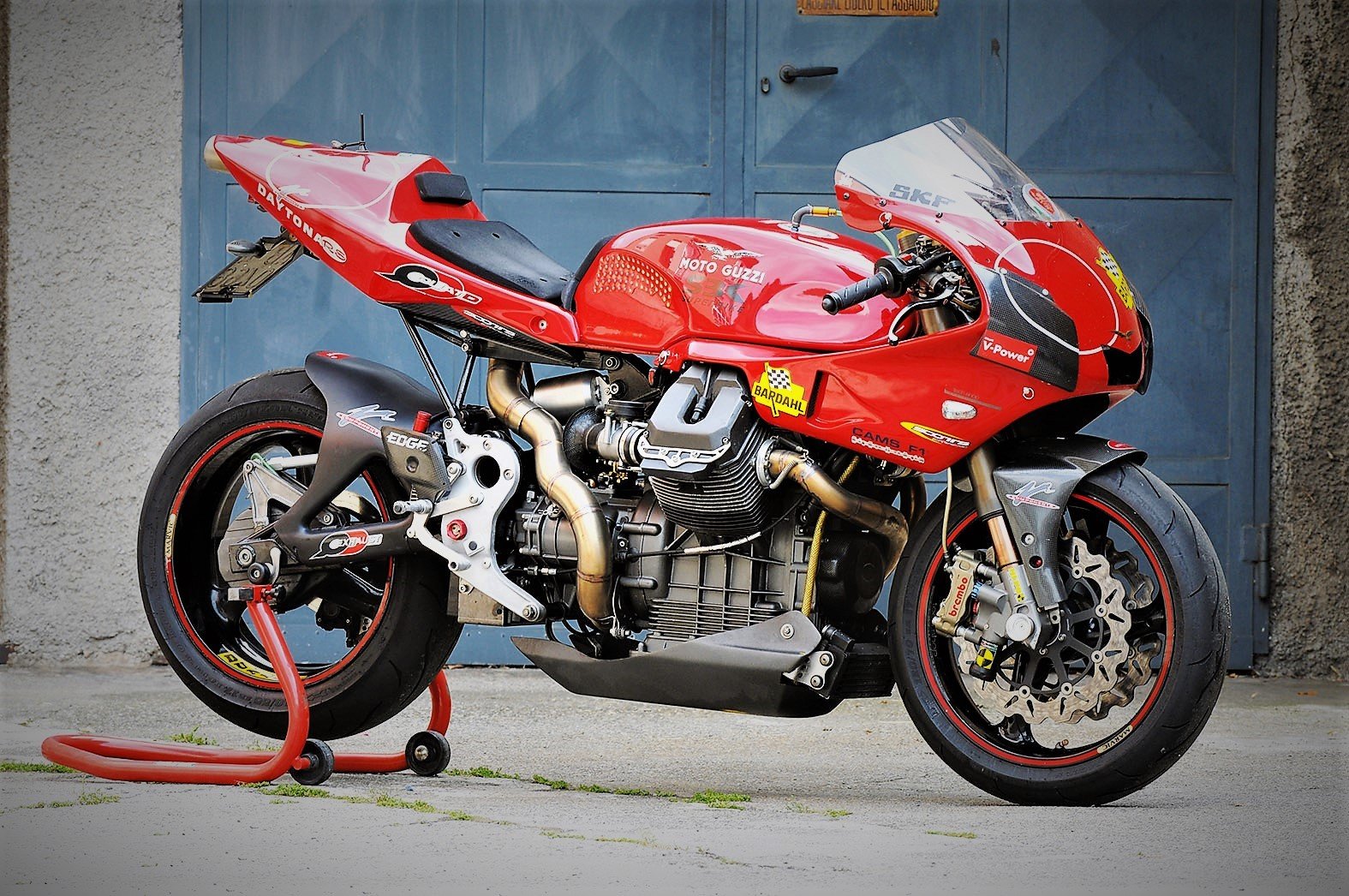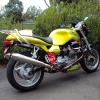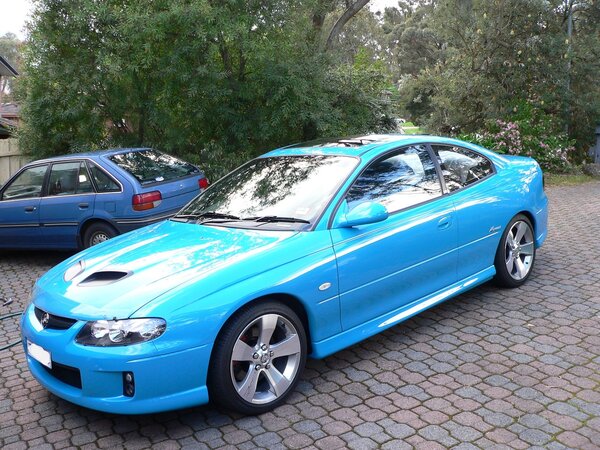-
Posts
5,234 -
Joined
-
Last visited
-
Days Won
268
Content Type
Profiles
Forums
Events
Gallery
Community Map
Everything posted by Lucky Phil
-
Pull the tank and clean and inspect, same for the injectors and fuel filter. The injectors will probably need professional cleaning and the filter changing. Pull the plugs and rotate the engine by hand then on the starter with the plugs out make sure the LOP light goes out then drop the oil and filter and replace both. Replace all the brake and clutch fluids and bleed. Check the airbox and filter for dirt and critters then the usual stuff. Unless it leaks after you get it running then any engine and gearbox seals seals should be fine. Ciao
-
From the album: lucky phils V11
-
No the ST2 was red, the TT2 was red, the 1198 is red, the bevel 750 Sport was yellow, the Hailwood Mille was red white and green, the 750 GT was Bronze, the 750 Sport belt engined bike was Matt Black then red, the 1098 was red. That's just the Ducati's. I've owned my fair share of red bikes it's fair to say I actually wanted a Black 1198 but one wasn't available at the time. When I bought the 1000ss I also wanted a red one as well and have a full set of bodywork and a good second hand tank ready to paint red which was my intention. I then about 5 or 6 years later went to a motorcycle gathering and on display was a couple of 1000ss bikes in red and was actually happy mine was yellow. Not that yellow would have been my first choice but it seems that red is a very "safe" choice for a bike colour but it dates a bit quickly I think. Each car or bike has it's 'best colour" whatever that may be. I wouldn't choose a car in the yellow the 1000ss is as to me it's not really a colour for a car with so much painted area. My old Monaro was blue and that colour looked great on it but it didn't look good at all on the sedan or ute version of that model. my Focus RS in Blue Ciao
-
The washer is there so the shoulder of the bolt tightens down on a flat steel face and not the alloy pork chop and also as a surface for the brake pivot bush and housing to bear against. Cant remember off hand but 3mm sounds about right. Ciao
-
Should re name this "show us your pork chops" lol. Hers mine after I painted them in 2k. Ciao
-
Here's a tip before you write off any sealed bearing because it feels stiff esp after greasing. use a small screw driver watchmakers or tooth pick or similar and lift the grease fitting ball off it's seat a fraction and release any pressure in the bearing. Sometimes they will actually let out a pssst and shoot a little squirt of grease. The bearing will now turn freely. Internal pressure on the seals is the issue. Used to happen greasing aircraft regularly. Ciao
-
Yes so the V11 figures should be pretty close. Ciao
-
With your figures I get 109.982 trail for the Griso and 95.758 for the V11. Ciao
-
My calcs must be pretty close as I get the Griso at 110mm trail using assumptions about front tyre dimensions and fork length. Remember a Griso uses traditional style wide handlebars compared to a v11 clipon style as well which gives more leverage. Ciao
-
I assume so from my calculations but I'm open to being corrected by attributable material. In broad terms it's not a major issue if my actual figures aren't exactly correct it's more about the differential between the various permutations based on the same baseline data I used. Ciao
-
I personally wouldn't assume that. Ciao
-
You need to look at these charts with a careful eye. I've spent hours and hours researching these in the past and they very often contradict themselves or aren't comprehensive or detailed enough. This chart for instance look like it's geared more to the mining industry than the automotive and therefor I personally wouldn't rely on it entirely for motorcycle work. Not saying it's wrong but if you look at enough of them you start to get an idea of where their focus is and it makes a difference.I don't see Gasoline on this one and it's important not to extrapolate general stuff into specifics such as Hydrocarbon or tolulene into gasoline. I've seen these charts indicate that Nitrile is fine in Gasoline which it is for a trapped seal but not as a dynamic seal and some Nitrile is better in fuel than other compounds. Even constrained nitrile seals when removed have swelled in gasoline and cant be reused so you need to not rely on any one particular of these generic charts as they can and do vary quite a bit. Ciao
-
Good question. I've dealt with orings of various types and materials all my life in aviation and motorcycles and cars. We had at one point issues with leading edge actuators leaking hydraulic fluid on long flights but were fine on shorter flights of sub3 hours. Of course when they did leak in cruise on the longer flights by the time the aircraft got on the ground the leak had disappeared. So long cruise and we had passengers taking images through the cabin windows of hydraulic oil coming off the trailing off the wing and when the aircraft arrived at the next port zero leaks. Quite frustrating to deal with from a certification perspective. The reason? Well the manufacturer had decided to change the actuator oring material to "something better" problem was the "something better" wasn't actually that great at -45 deg C 42,000' foot cruise for more than a few hours. Cold soak set in and so did the leaks. Long descant to warmer air for landing and the problem disappeared. With regards to motorcycles the applications are pretty straight forward and as is the case in situations like this when all the technical intricacies and materials start to get delved into by people I simply go back to what has actually worked in previous practice. Theory and intricate detail on form function and material has it's place of course but apart from the transition to FKM/Viton for engines from Nitrile everything else seems to work acceptably well. The one interesting exception that needs to be considered on modern engines though that catches many mechanics esp home mechanics out is the use now of Flurosilicon seals for cranks and some other areas. Lubricating these when installing actually causes them to leak. They rely on being installed dry and the first rotations of the shaft deposits material from the seal onto the shaft and creates the sealing effect. If you don't read the manual and aren't aware you can have a major job on your hands to do the seal replacement all over again. Ciao
-
sorry. As you can see it's slotted a fair way to relieve the stress. Best image I have.
-
You can get powder coating that mimics anodising these days. here's an example. The gassing off thing sound like rubbish to me. Ciao
-
The top mount in the image has been elongated quite a lot to relieve the cover of stress when affixed. Hard to understand how they got the placement so wrong. My bike has my own design and manufactured mount screws as well so the elongation isn't quite as obvious. You can but button head allow 5mm screws and do something similar. It's not noticeable when fitted if done accurately. Ciao
-
I think it's a good idea to spacer up the rear tank mount to stop the tank rubbing the paint off the side covers. The covers are very prone to cracking around the mount holes and it's a material thats very hard to repair even with plastic welding. The solution is to elongate the holes nicely esp the top one which allows the cover to fit without stressing the thing. I can supply an image if you want to do it. Ciao
-
I've been pointing this out for years to people. A fancy solid colour/carbon look tank scratch pad saves the scratches but then you have an issue with paint fade. So you need to buy a spare to replace it in time AND replace it perfectly aligned with the old one. Good luck with that. The best option? A clear scratch pad like I've always used. May look less sexy/trendy but a much smarter option. Make yourself a new solid pad thats slightly larger than the removed one that compensates for the off centre issue. Then you can have a centred pad that covers the fading paint. Ciao
-
So here's my calculation docc. A std 1100ie Sport 26deg/45mm offset combination has approx trail of 96mm. If someone has the guaranteed actual figure let me know. Working on the same assumptions for fork length and front tyre OD a std V11 Sport with a 25deg/40mm offset triple also has 96mm trail. Now if you use a set of 1100ie Sport triples with 45mm offset on the V11 Sport so you get a 25deg/45mm offset combo you end up with 90mm of trail. A significant difference towards the "sharper steering" end of the spectrum. My 1198 has 30mm offset aftermarket triple clamps down from the std 36mm offset so it steers better on the track and doesn't push the front on corner exit on the throttle. That 6mm on the Ducati makes a lot of difference to the steering so 5mm offset and 6mm trail on the Guzzi V11 is a significant change to the steering and stability. I think this is probably whats happened back on the early bikes. We'll know for certain when I pull the triples on my bike after I get the replacement forks sorted and I can measure the supposed "cant" on my bikes original triples. If you had a std V11 Sport 25/40 set up and canted the triples 1/2 deg you'd go from 96mm to 103mm trail. If you instead opened the head angle to 25.5 you'd go from 96mm to 99mm trail. If you had 1100ie 45mm triples on a V11 sport and you "canted" the triples 1/2 degree you'd end up with 97.5mm trail from 90mm. Seems to me the most likely scenario is they started with 1100ie Sport triples at 45mm offset and then due to customer/journalist feedback increased the trail from 90mm to 96mm by virtue of 40mm offset triple clamps to bring the figures back to the same as a std 1100ie Sport. Ciao
-
Can confirm the V11's have 40mm offset docc. If you look at an image of an 1100ie Sport the triples look identical but do in fact measure 45mm offset. Ciao
-
Sport 1100's had 45mm offset triple clamps on a 26deg head angle from what I can see. The V11 Sport has a 25 deg head angle and 40mm offset clamps. If you had 45mm offset triples on a 25 deg frame it would be intrinsically less stable compared to the 45X26 due to the greatly reduced trail not only from the steeper head angle but also the extra offset. If Guzzi originally fitted Sport 1100ie triple clamps at 45mm off set on the 25 deg V11 frame maybe they were a little too twitchy so they went for 40mm offset forks to increase the trail and get some stability back on the later bikes. Ciao
-
Hold on here, 250F is 121C and some BB engines can see 140 deg C bulk oil temp under some conditions and 100 deg C is common. Nitrile is good to around 100 deg C which is ok for an easy to replace oring like this or on the filter where it's going to be replaced regularly but just about everywhere on an engine a Nitrile oring is at it's limit. This is why Guzzi have been slowly phasing them out for FKM seals which Ducati did years ago as well. Ciao






